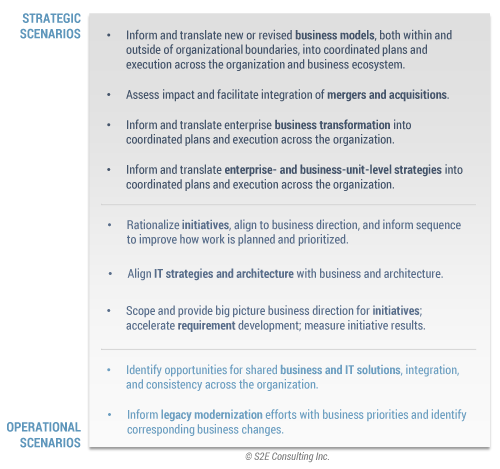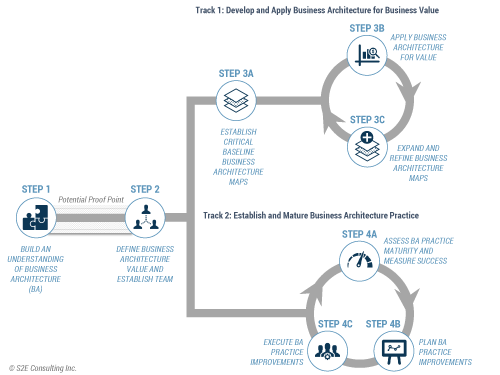B & EA EXECUTIVE UPDATE VOL. 19, NO. 5

Business architecture is proving itself to be a critical discipline for bridging the gap between strategy and execution. Whether encouraged by the increasing speed that the discipline is growing globally or their own firsthand experiences with its value, organizations are continuing to invest in establishing internal business architecture practices. However, many do not realize the full potential of what business architecture can achieve for an organization when fully matured. In fact, many do not have a clear vision of what “fully mature” even means. This Executive Update will paint a picture of what a mature business architecture practice looks like, summarize the achieved value as a result, and provide a practical perspective on how to get there.
Defining a “Mature” Business Architecture Practice
There are frameworks we can use to concretely measure the maturity of each key aspect of a business architecture practice. For example, the industry standard Business Architecture Maturity Model (BAMM) helps organizations understand the level at which they are performing related to various dimensions, including business architecture mapping, tools, governance, methods, people, management involvement, and alignment with related disciplines.
However, we can define the real test of maturity through a key set of characteristics that demonstrate acceptance of, and commitment to, the discipline. A mature business architecture and the supporting practice is:
- Invested by the organization. Investment signifies perceived value and commitment. Mature business architecture practices receive the resources and funding they need to be maintained and to continually improve. This includes various resources to keep the business architecture evergreen, advance the people and the methods, and address the demand for applying business architecture across various scenarios and domains.
- Valued across the organization. Business architecture and business architects are continually requested, expected, or even required for strategic, planning, and solution development activities across the enterprise. They are at the table for strategic conversations, including strategy development, business model evolution, mergers and acquisitions, and enterprise transformation. In many cases, business architects become trusted advisors to business and IT leaders.
- Embedded into the fabric of the organization. The ideal state is for business architecture and business architects to become fully integrated into the functions and disciplines of the organization — from strategy to execution. Business architecture becomes the way business is done, not something separate or additive that is seeking to prove its value.
Possibilities for Business Architecture
The full potential of business architecture is sweeping, sometimes making it a challenge for people to fully understand and determine where to start. Its value is not only in providing a common business language and mental model and the inherent benefits that come from that, but in all the scenarios where an organization can use it to provide enterprise-level context, framing, analysis, and communication across the strategy execution lifecycle. In fact, in many cases, business architecture itself is not the deliverable but rather used as a framework for other content.
As a business architecture practice matures (and assuming it is coupled with IT architecture), the value it can deliver increases in strategic nature, scope, and complexity. As Figure 1 highlights, organizations can use business architecture to increase the success of various operational and strategic scenarios. Business architecture is most powerful in situations that require a cross-business-unit perspective, versus just a single one, as illustrated by these examples.

Figure 1 – Example scenarios where business architecture delivers value.
The Path to a Successful Business Architecture Practice
Establishing a successful, sustainable business architecture practice is a journey that takes time, especially within large organizations. While there are always many ways to achieve an outcome, Figure 2 shows a practical and well-tested path to accelerate the process of establishing and maturing a practice.

Figure 2 – Path to a successful business architecture practice.
The first two steps provide a foundation for all others that follow and it is difficult to succeed when these initial steps are not executed well. The path starts with building an understanding of business architecture, including the scope of what it is and is not, how it can be used, and how it can be integrated into an organization. The next step is defining business architecture value to the organization and establishing the team. Business architecture value must be clearly, simply, and consistently articulated to all stakeholders, including the business architecture team itself. This will serve as a compass for all business architecture activities, informing decisions and priorities. To establish the team, organizations create a charter, define and implement an organizational structure, and hire team members.
After establishing the business architecture value and team, the rest of the path proceeds along two parallel tracks, both of which are important and related. The first track is the primary one for developing and applying business architecture for business value. The loop within this track will continue indefinitely, though the applications for business architecture will likely grow in scope and complexity over time. The second track is for establishing and maturing the business architecture practice, which includes all supporting aspects, such as developing people, governing methods and practices, managing tools, integrating into the organization, and measuring success. This loop will also continue indefinitely, but once a practice reaches a state of desired maturity, the focus becomes more on continuous improvement versus large steps of advancement.
Within Track 1, Step 3A establishes critical baseline business architecture maps, such as an enterprise capability map, basic information map, and core value streams. Of course, the entire business architecture baseline could be mapped initially, but this is not always feasible for some organizations for various reasons. Business architecture is then put into action quickly in Step 3B to start providing business value, in alignment with the vision defined in Step 2. Step 3C continually expands the business architecture baseline by adding new types of mappings, such as for strategies, products, and initiatives, and it also refines the content of the entire knowledgebase as needed. The expansion activities in Step 3C are typically prioritized based on the types of scenarios in which business architecture will be applied during Step 3B, particularly in the case of a new practice where limited resources are available.
Within Track 2, there is a continual loop for maturing the business architecture practice that starts in Step 4A with an assessment of the current practice maturity and measurement of its success. Along with the practice of goal setting, this leads to Step 4B, which is where enhancements are planned for the practice over the next horizon. Step 4C executes on those changes, which are measured again in Step 4A. This loop typically occurs as an annual planning process, where measurement, goal setting, and next-horizon planning for the business architecture practice is done at the end of the year, and then practice enhancements are executed upon during the following year. It is critically important that the planned practice enhancements align with how business architecture is being applied in Step 3B. The most practical approach to building and scaling a practice is to do just enough, just in time, in order to support the current business architecture scenarios.
Some organizations are not able initially to obtain full buy-in to establish a business architecture team as described in Step 2. In these cases, they may need an additional period of time to prove the value and gain support. Some basic baseline business architecture maps may still be built (but not to full detail) and then applied to an initial scenario or two. During this proving period, it is still important to build the maps with an enterprise and long-term-usage perspective, to select scenarios that will demonstrate the true value of business architecture (e.g., cross-business unit), to execute quickly and well, and to share the success to build advocacy. Once achieving this, Step 2 can begin.
Critical Success Factors
While the tendency may be to dive in and start mapping the business architecture because that is what is comfortable or what the industry conversation sometimes seems to focus on, it is important to be deliberate about establishing a business architecture practice, which is about much more than mapping. Adhering to a few proven critical success factors (a number of which were alluded to in Figure 2) will greatly increase the long-term success of a business architecture practice:
- Take time to fully understand the business architecture discipline. A solid understanding of the boundaries and appropriate usage scenarios for business architecture greatly reduces time and confusion while establishing the discipline within an organization.
- Know and communicate the value provided to the organization. A business architecture team that has a clearly defined and attainable value proposition is more readily accepted within an organization and operates in a more efficient and focused way, guided by well-understood priorities and stakeholders.
- Focus on business value. Delivering business value should be the number-one priority, while other activities are performed in support of it. A focus on results creates quicker buy-in and investment to scale the practice.
- Integrate with related functions and disciplines. Business architecture exists within, and enables a broader ecosystem of, teams that work together to develop and execute on strategy for an organization. Deliberate integration of the business architecture practice with other teams, not only by building relationships but also through integrating processes and roles where applicable, helps to truly embed the discipline within an organization.
- Take communication and change management seriously. Simply introducing business architecture to an organization creates change, as well as some of the bigger impacts it catalyzes such as cross-business-unit collaboration. Deliberate organizational change management and communication increases adoption and mitigates risks for the practice. A new business architecture practice requires planning and “marketing” to tell the story.
- Execute well. As with any idea, a new business architecture practice only becomes a reality and is adopted when it is executed well. Commit resources and execute along the two tracks, guided by delivering business value and developing just enough practice infrastructure, just in time, to support it.
Organizations that have the commitment and persistence to invest in and mature their business architecture practice will reap the benefits going forward, not the least of which is the ability to execute strategies in a more accelerated, coordinated, and efficient way. In today’s environment of rapid change, this makes business architecture a critical discipline and one that leads to competitive advantage when implemented successfully.



